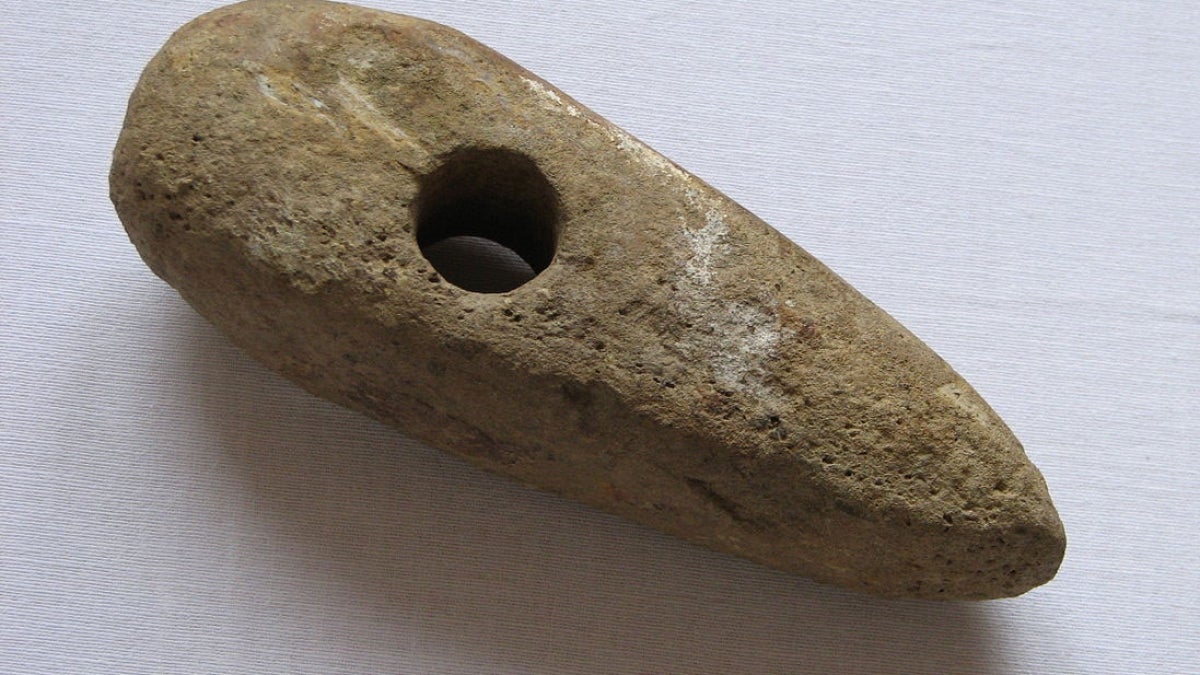Being human: ASU study looks at how we began to make it

Leaps forward in tools — such as this stone axe/hammer from Slovenia — are an example of how humans learn things from others that we couldn’t learn on our own.
Photo by: Wikipedia Commons
How did humans get from using stone tools to using power tools?
Not on their own, according to the results of an Arizona State University study released Thursday in the journal Nature Communications.
While the occasional Edison or Einstein can produce a dramatic innovation in one fell swoop, the experiment found that groups of people can create things more complex than a single individual can in the same amount of time.
Technology has allowed people to live in places to which they’re poorly suited, like the Arctic and the Sahara. However, we don’t have a good understanding of how humans produce the complex technologies that allow them to exist where they shouldn’t.
“There’s no other animal species that adapts to as wide a range of habitats as humans, and the way we do that is by learning from each other,” said Rob Boyd, co-author of the study. Boyd is Origins Professor in the School of Human Evolution and Social Change and research affiliate in the Institute of Human Origins.
“The idea is that people make gradual improvements, generation after generation, and on timescales that are long,” he said.
The study — a computer-based experiment, involving humans and learning bots — is the first demonstration of cumulative cultural evolution within the lab, said co-author Maxime Derex, a postdoctoral research associate in the Institute of Human Origins.
The experiment involved a computer game in which participants had to build virtual "totem poles" by discovering increasingly complex innovations. Some individuals solved the problem on their own, while others could observe the solutions of other members of their group. The researchers found that human reasoning plays a part in innovations, but they also found that participants with access to social information were able to create more complex artifacts than individuals.
“In this experiment, we wanted to make sure that populations of individuals are able to accumulate more information than single individuals,” Derex said.
Specialists aren’t characteristic for most of human history, according to Boyd.
“There is some division of labor with age — old men tend to sit around and give advice — but there’s not much specialization in skills,” he said. “Everybody does everything. And yet you have tons of accumulation. You get lots of fancy things that are completely beyond the learning capacity of individuals on their own without any specialization.”
One of the things that distinguish humans from other animals is that we learn stuff from other people we couldn’t learn on our own. It’s not about a single guy figuring something out and teaching everyone else. It’s more like a group of people sitting around going, “Hey, you know what worked for me on this?”
Tools are the easiest example, said Boyd. If you go back 200,000 years, you see very simple stone tools. Then, around 70,000 years ago, a burst of what the study calls “cultural complexity” occurred. Beautifully made spear points began to appear. No one knows why, Boyd said.
“We don’t really know what the transition was that allowed people to start learning from each other,” he said. “Whatever it was, that’s a good candidate for why we had this big increase in learning. … As soon as people can learn from each other in a way that allows cumulative knowledge, you can get all kinds of stuff accumulating and that allows for this efflorescence of technology.”
Scientists don’t know whether the change was in the brain or something else.
“And why did it happen there, and then?” Boyd said. “It’s not clear. It happens all the time in evolution.”
Most animals can’t learn much from each other. Humans are very good at it.
“Cultural transmission, where we learn from each other, requires a bunch of mental cognitive tools that humans have and other animals don’t seem to have,” Boyd said. “Accumulation allows populations to create things little bit by little bit.”
The study was funded by the John Templeton Foundation to the Institute of Human Origins. The $4.9 million, three-year grant, the largest of its type for human origins research, will support 11 linked investigations of where, when and how unique human capacities for complex cognition, cumulative culture, and large-scale cooperation emerged.
More Arts, humanities and education

ASU alumna makes her way back to the ASU Gammage stage for '¡azúcar!'
As the Los Angeles-based CONTRA-TIEMPO dance group prepares for its upcoming production “¡azúcar!” at ASU Gammage, for one member…

ASU FIDM professor wins international award for fantastical, sustainable creation
The horror of an ailing Earth inspired an Arizona State University fashion professor to create a fantastical garment out of…

ASU workshop trains educators, professionals from marginalized communities in disaster science
As devastating as hurricanes can be to anyone caught in their paths, they strike marginalized communities even harder.To address…